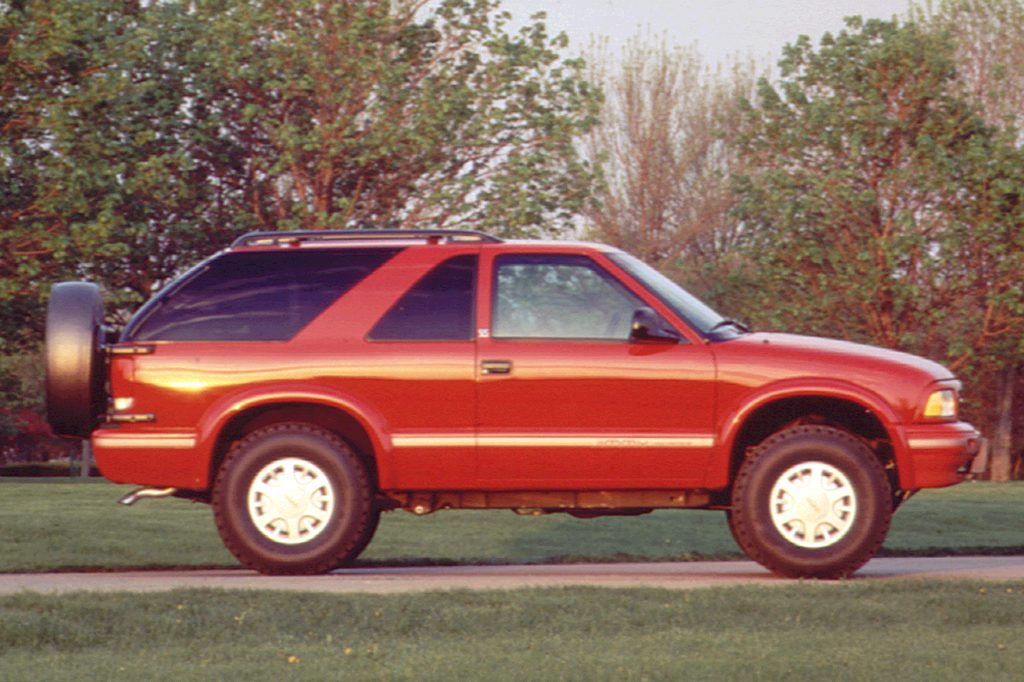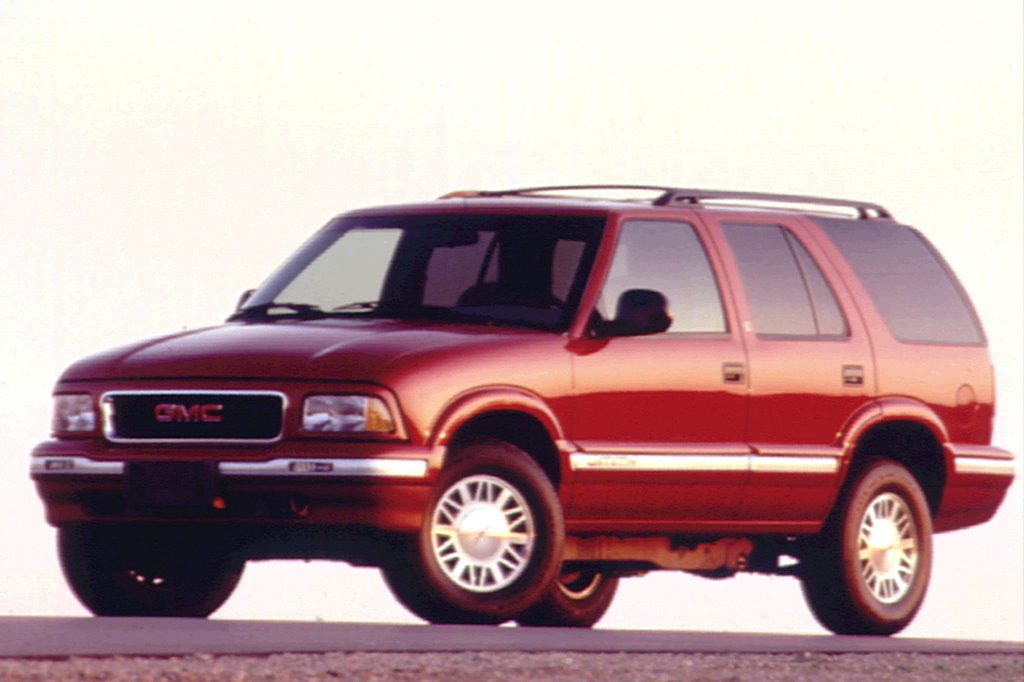| 2000 GMC Jimmy/Envoy |
Pricing Effective: 06/22/2000 |
| Model Pricing |
Retail Price |
Dealer Price |
Destination |
| Jimmy SLS 2-door wagon, 2WD |
$ 19,170 |
$ 17,349 |
$ 575 |
| Jimmy SLS 2-door wagon, 4WD |
22,170 |
20,064 |
575 |
| Jimmy SLS Convenience 2-door wagon, 2WD |
22,070 |
19,973 |
575 |
| Jimmy SLS Convenience 2-door wagon, 4WD |
25,070 |
22,688 |
575 |
| Jimmy SLE 4-door wagon, 2WD |
26,670 |
24,136 |
575 |
| Jimmy SLE 4-door wagon, 4WD |
28,670 |
25,946 |
575 |
| Jimmy SLT 4-door wagon, 2WD |
27,970 |
25,313 |
575 |
| Jimmy SLT 4-door wagon, 4WD |
29,970 |
27,123 |
575 |
| Jimmy Diamond Edition 4-door wagon, 2WD |
29,670 |
26,851 |
575 |
| Jimmy Diamond Edition w/1SH 4-door wagon, 4WD |
31,670 |
28,661 |
575 |
| Jimmy Diamond Edition w/1SK 4-door wagon, 4WD |
33,470 |
30,290 |
575 |
| Envoy 4-door wagon, 4WD |
34,565 |
31,281 |
575 |
| Price Note: Diamond Edition w/1SK requires Marketing Pkg. |
| Standard Equipment |
| Jimmy SLS : 4.3-liter V6 engine, 5-speed manual transmission, limited-slip differential, dual front airbags, antilock 4-wheel disc brakes, daytime running lights, air conditioning, variable-assist power steering, reclining cloth front bucket seats with lumbar adjusters, center storage console, cupholders, split folding rear seat, tachometer, AM/FM/cassette, digital clock, automatic headlights, intermittent wipers, passenger-side visor mirror, floormats, theft-deterrent system, dual outside manual mirrors, black roof rack, deep-tinted rear side glass, tailgate, Euro-Ride Suspension, full-size spare tire, 235/70R15 tires, alloy wheels, 4WD adds: part-time 4-wheel drive with electronic transfer case, front tow hooks |
| Jimmy SLS Convenience/SLE add: 4-speed automatic transmission, tilt leather-wrapped steering wheel, cruise control, 8-way power driver seat (SLE), AM/FM/CD player, heated power mirrors, driver-side automatic day/night mirror (SLS Convenience), power windows, power door locks, remote keyless entry, illuminated visor mirrors, overhead console w/storage, compass, outside temperature indicator, map lights, cargo cover (SLE), rear defogger, rear intermittent wiper/washer, power remote liftgate release, deep-tinted tailgate glass, liftgate/liftglass (SLE), Luxury Ride Suspension (SLE), (Deletes limited-slip differential), 4WD adds: part-time 4-wheel drive with electronic transfer case, front tow hooks |
| Jimmy SLT adds: leather upholstery, 8-way power driver seat, cargo cover, fog lights, liftgate/liftglass, Luxury Ride Suspension, (Deletes automatic day/night driver-side and rearview mirrors), 4WD adds: Autotrac full-time 4-wheel drive with electronic transfer case, front tow hooks |
| Jimmy Diamond Edition adds: leather upholstery w/special diamond pattern stitching, special trim and badging, brushed aluminum roof rack, 7-wire trailering harness, heavy-duty hitch platform and flasher, 4WD models adds: Autotrac full-time 4-wheel drive w/electronic transfer case, front tow hooks, 235/75R15 on/off-road tires |
| Envoy adds to Jimmy SLT: Autotrac full-time 4-wheel drive, electronic transfer case, automatic climate control, heated front seats w/power lumbar adjustment, driver seat memory, 8-way power passenger seat, wood interior trim, heated power mirrors w/driver-side automatic day/night, Bose AM/FM/cassette w/6-disc CD changer, steering wheel radio controls, trip computer, universal garage door opener, automatic day/night rearview mirror, intermittent rear wiper/washer, rear liftgate/liftglass, high-intensity headlights, load-leveling suspension, front tow hooks, 7-wire trailering harness, heavy-duty hitch platform and flasher |
| Optional Equipment |
| Option Note: |
| Major Packages |
| Option |
Avail. |
Retail |
Dealer |
| 1SD SLE Luxury Marketing Pkg. |
SLE |
$1250 |
$1075 |
| Automatic day/night rearview and driver-side mirrors, 8-way power passenger seat, Bose sound system, steering wheel radio controls, trip computer, universal garage door opener. |
| 1SF SLT Luxury Marketing Pkg. |
SLT |
1995 |
1716 |
| Automatic climate control, OnStar System (Global Positioning System, roadside assistance, emergency services), heated front seats, driver seat memory, 8-way power passenger seat, Bose sound system, steering wheel radio controls, automatic day/night rearview and driver-side mirrors. |
| 1SJ Diamond Edition Special Marketing Pkg. |
2WD Diamond Edition, 4WD Diamond Edition w/1SH |
1995 |
1716 |
| Automatic climate control, OnStar System (Global Positioning System, roadside assistance, emergency services), heated front seats, driver seat memory, 8-way power passenger seat, Bose sound system, steering wheel radio controls, automatic day/night rearview and driver-side mirrors. |
| 1SK Diamond Edition Special Marketing Pkg. |
4WD Diamond Edition w/1SK |
1445 |
1243 |
| 1SJ Diamond Edition Special Marketing Pkg. plus AM/FM/cassette w/automatic tone control, 6-disc CD changer, rear seat radio controls, high-intensity headlights, load-leveling suspension. |
| ZQ3 Convenience Pkg. |
SLS |
395 |
340 |
| Cruise control, tilt steering wheel. |
| ZQ6 Convenience Pkg. |
SLS |
535 |
460 |
| Heated power mirrors, power windows and door locks. |
| Rear Window Convenience Pkg. |
SLS |
322 |
277 |
| Power remote tailgate/liftgate release, rear defogger, rear intermittent wiper/washer. |
| Heavy-duty trailering equipment |
SLS, SLS Convenience, SLE, SLT |
210 |
181 |
| Weight distributing hitch platform, 7-lead wiring harness, heavy-duty flasher. |
| Powertrain |
| Option |
Avail. |
Retail |
Dealer |
| 5-speed manual transmission |
SLS Convenience (credit) |
-1000 |
-860 |
| 4-speed automatic transmission |
SLS |
1000 |
860 |
| Deletes limited-slip differential. |
| Autotrac full-time 4WD |
4WD SLS Convenience, 4WD SLE |
225 |
194 |
| Optional axle ratio |
Jimmy |
0 |
0 |
| Limited-slip differential |
|
270 |
232 |
| Comfort & Convenience Features |
| Option |
Avail. |
Retail |
Dealer |
| Power sunroof |
|
750 |
645 |
| NA SLS. |
| 6-way power driver seat |
SLS Convenience |
240 |
206 |
| Overhead console |
SLS |
147 |
126 |
| Includes storage, outside temperature indicator, compass. |
| Deluxe overhead console |
SLS Convenience |
130 |
112 |
| Includes storage, trip computer, universal garage door opener, outside temperature indicator, compass. |
| AM/FM/cassette |
2-door |
80 |
69 |
| Includes automatic tone control. |
| AM/FM/CD player |
SLS |
180 |
155 |
| AM/FM/cassette/CD player |
2-door |
100 |
86 |
| 6-disc CD changer |
|
395 |
340 |
| Std. Diamond Edition w/1SK, Envoy. NA with 5-speed manual transmission. |
| Bose sound system |
2-door |
495 |
426 |
| NA w/5-speed manual transmission, AM/FM/cassette/CD player. |
| Steering wheel radio controls |
SLS Convenience |
125 |
108 |
| NA with 5-speed manual transmission. |
| Cargo cover |
4WD 2-door |
69 |
59 |
| Requires exterior spare tire carrier. |
| Appearance and Miscellaneous |
| Option |
Avail. |
Retail |
Dealer |
| Tailgate |
SLE, SLT, Diamond Edition |
0 |
0 |
| Deep-tinted liftgate glass |
SLS |
115 |
99 |
| Fog lights |
2WD SLS Convenience |
115 |
99 |
| Two-tone paint |
SLE, SLT |
225 |
194 |
| Engine block heater |
Envoy |
20 |
17 |
| Special Purpose, Wheels and Tires |
| Option |
Avail. |
Retail |
Dealer |
| Shield Pkg. |
Jimmy 4WD |
126 |
108 |
| Front differential skid plates, transfer-case, steering-linkage and fuel-tank shields. |
| Euro-Ride Suspension Pkg. |
SLE, SLT, 2WD Diamond Edition |
0 |
0 |
| Bilstein gas shock absorbers (2WD), DeCarbon shock absorbers (4WD), larger stabilizer bars, heavy-duty springs. |
| Off-Road Suspension Pkg. |
4WD SLS Convenience |
245 |
211 |
| Bilstein gas shock absorbers, heavy-duty springs and body mounts, larger stabilizer bars. Requires 235/75R15 on/off-road white-letter tires. |
| 235/70R15 white-letter tires |
2-door, 2WD SLE, 2WD SLT |
133 |
114 |
| 235/75R15 on/off-road white-letter tires |
4WD 2-door |
168 |
144 |
| Exterior spare-tire carrier |
4WD 2-door |
159 |
137 |





